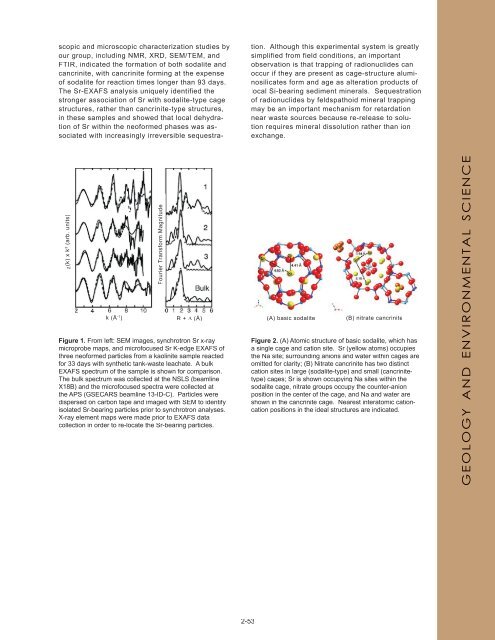NSLS Activity Report 2006 - Brookhaven National Laboratory
NSLS Activity Report 2006 - Brookhaven National Laboratory
NSLS Activity Report 2006 - Brookhaven National Laboratory
You also want an ePaper? Increase the reach of your titles
YUMPU automatically turns print PDFs into web optimized ePapers that Google loves.
scopic and microscopic characterization studies by<br />
our group, including NMR, XRD, SEM/TEM, and<br />
FTIR, indicated the formation of both sodalite and<br />
cancrinite, with cancrinite forming at the expense<br />
of sodalite for reaction times longer than 93 days.<br />
The Sr-EXAFS analysis uniquely identified the<br />
stronger association of Sr with sodalite-type cage<br />
structures, rather than cancrinite-type structures,<br />
in these samples and showed that local dehydration<br />
of Sr within the neoformed phases was associated<br />
with increasingly irreversible sequestra-<br />
χ(k) x k 3 (arb. units)<br />
k (Å -1 )<br />
Fourier Transform Magnitude<br />
R + ∆ (Å)<br />
Figure 1. From left: SEM images, synchrotron Sr x-ray<br />
microprobe maps, and microfocused Sr K-edge EXAFS of<br />
three neoformed particles from a kaolinite sample reacted<br />
for 33 days with synthetic tank-waste leachate. A bulk<br />
EXAFS spectrum of the sample is shown for comparison.<br />
The bulk spectrum was collected at the <strong>NSLS</strong> (beamline<br />
X18B) and the microfocused spectra were collected at<br />
the APS (GSECARS beamline 13-ID-C). Particles were<br />
dispersed on carbon tape and imaged with SEM to identify<br />
isolated Sr-bearing particles prior to synchrotron analyses.<br />
X-ray element maps were made prior to EXAFS data<br />
collection in order to re-locate the Sr-bearing particles.<br />
2-53<br />
tion. Although this experimental system is greatly<br />
simplified from field conditions, an important<br />
observation is that trapping of radionuclides can<br />
occur if they are present as cage-structure aluminosilicates<br />
form and age as alteration products of<br />
local Si-bearing sediment minerals. Sequestration<br />
of radionuclides by feldspathoid mineral trapping<br />
may be an important mechanism for retardation<br />
near waste sources because re-release to solution<br />
requires mineral dissolution rather than ion<br />
exchange.<br />
(A) basic sodalite (B) nitrate cancrinite<br />
Figure 2. (A) Atomic structure of basic sodalite, which has<br />
a single cage and cation site. Sr (yellow atoms) occupies<br />
the Na site; surrounding anions and water within cages are<br />
omitted for clarity; (B) Nitrate cancrinite has two distinct<br />
cation sites in large (sodalite-type) and small (cancrinitetype)<br />
cages; Sr is shown occupying Na sites within the<br />
sodalite cage, nitrate groups occupy the counter-anion<br />
position in the center of the cage, and Na and water are<br />
shown in the cancrinite cage. Nearest interatomic cationcation<br />
positions in the ideal structures are indicated.<br />
GEOLOGY AND ENVIRONMENTAL SCIENCE

















